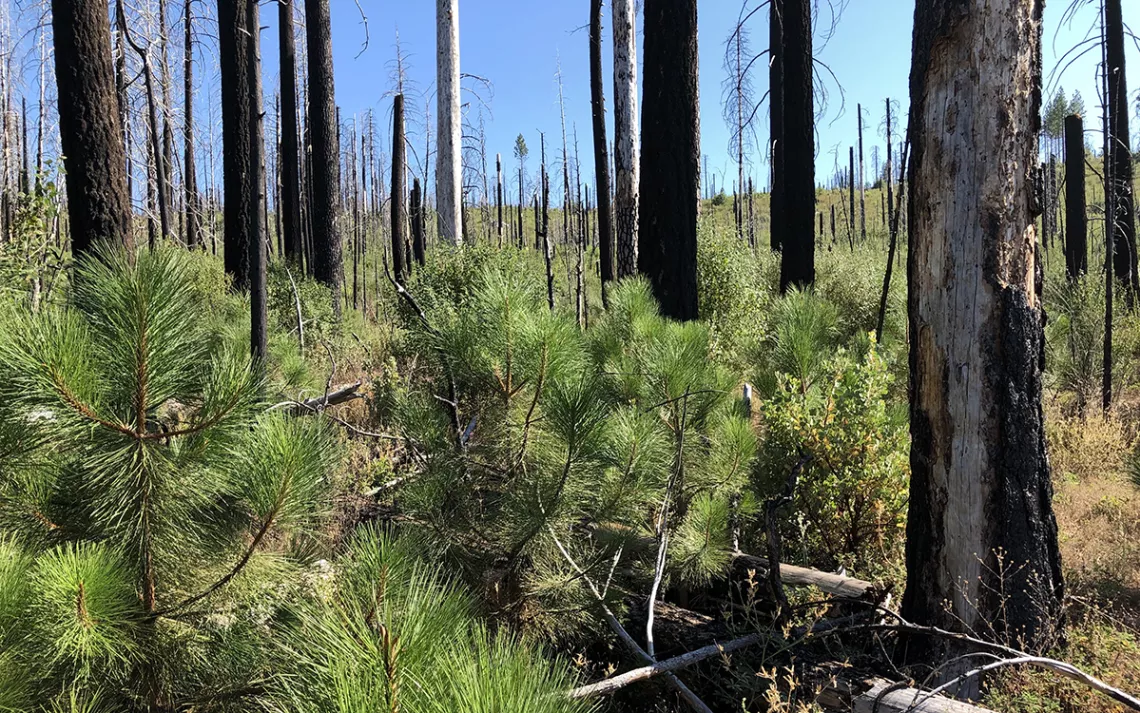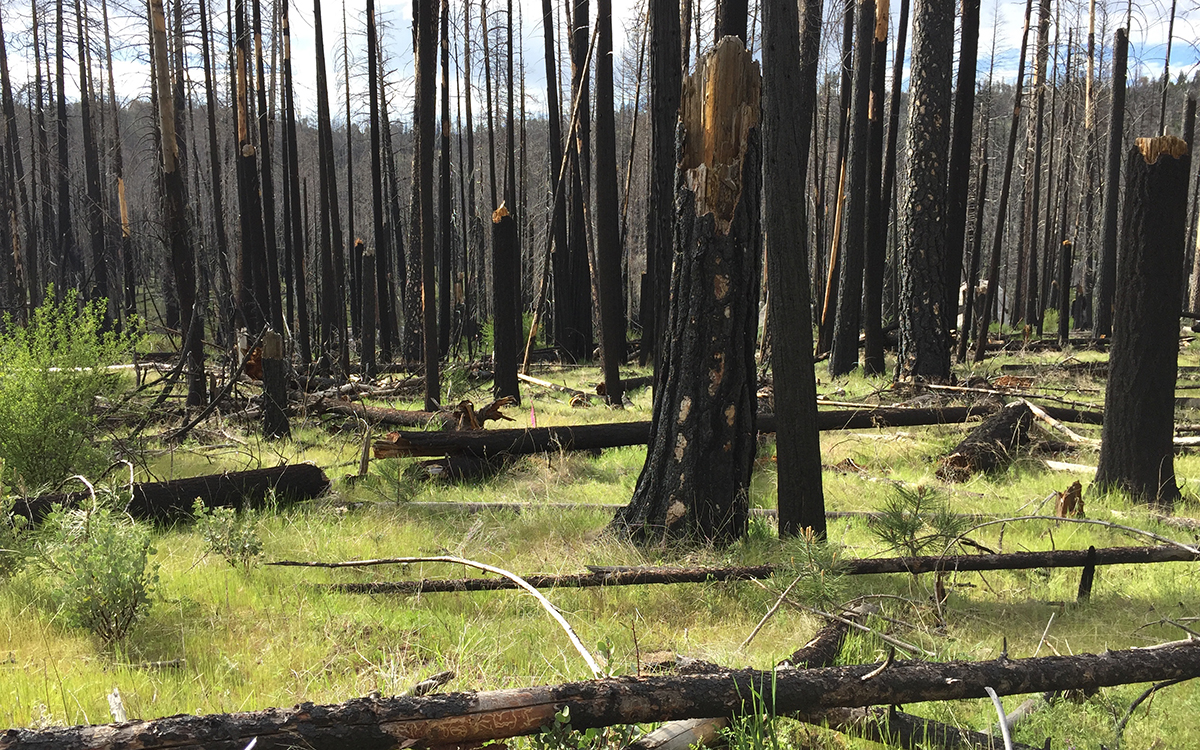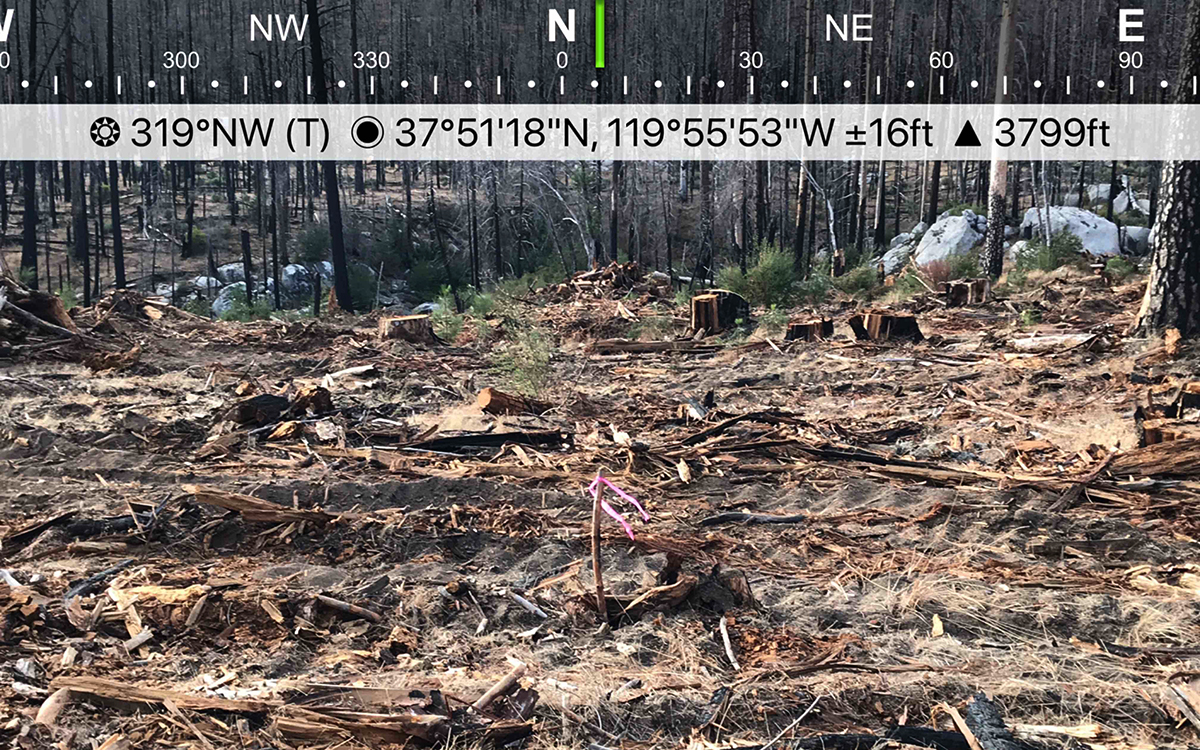Money to Burn
Forest advocates cry foul over converting post-fire trees into biomass energy

Snag forest wildlife habitat, created by a patch of high-intensity fire in the Rim Fire of 2013 in Stanislaus National Forest. | Photo by Chad Hanson
Off Forest Service Road 1S25 in Stanislaus National Forest, ecologist Chad Hanson stands on a dirt road between two fields, addressing a tour group. In one field, invasive cheatgrass shimmers a dull purple as it sways in the wind, giving way to scabby bald spots of brown dirt. The monochrome swath is punctuated by sun-bleached, flat-topped tree stumps and a few brownish conifer seedlings that stand roughly two to three feet tall. Up the road, a work crew drops branches into a wood chipper, which emits a dull drone.
In 2013, the Rim Fire ripped through this region, incinerating 257,314 acres in Tuolumne County and becoming the third-largest wildfire in state history. In the aftermath, the US Forest Service logged areas of severely burned forest, including this one patch of land. Once the burnt trees, or “snags,” were cut down and trucked out, rodenticide and glyphosate herbicide were applied to clear a path for new seedlings. Of the nursery-grown seedlings that were planted, Hanson estimates 95 percent were Ponderosa pines, with a few token cedars. “Like cornrows,” Hanson says.
On the other side of the dirt road, the post-burn field is decidedly greener, which Hanson attributes to the fact that it wasn’t logged. Gone are the sun-bleached stumps, and in their place stand tall, charred trunks that poke skyward from an undergrowth of shrubs and bushy, green saplings. A few blackened logs lay crumbling on the ground, speckled with orange fungus, around which flying insects dart. The saplings here are at least three times the size and abundance of their cousins across the road. At one blackened snag, Hanson points to coin-size pockmarks. He explains that woodpeckers make these holes, providing habitat for species that lack woodworking skills. Birdsong is audible.
“In terms of ecological value, snag forest is comparable if not more valuable than old growth,” says Hanson, who is a member of Sierra Club’s board of directors.
The Forest Service maintains that the dead wood supports little regeneration of tree stands, while logging and thinning promote forest health and mitigate the risk of future wildfires. But Hanson argues that these post-logged patches don’t rebound as well as the intact snag, which offer critical habitat for fire-dependent species.
In addition to the concerns that the post-fire logging is counterproductive, Hanson and other forest defenders are raising alarms that misappropriated federal dollars are funding much of the work. Moreover, they argue that some of the logged trees will likely be processed into fuel for a biomass energy facility—a second round of burning that, according to some climate scientists and air quality experts, represents a terrible climate calculus that puts even more carbon pollution into the atmosphere.
Post-fire logging on about 4,400 acres of national forest is being paid for with a $70 million Natural Disaster Relief Competition grant allocated by the federal Department of Housing and Urban Development (HUD) to its state counterpart, California Housing and Community Development (HCD), for the stated purpose of post-emergency relief and community resilience. According to the HCD proposal, $20 million is slated for two community resilience centers, while another $28 million goes to clearing biomass, spraying, burning, and replanting activities; the work, which the Forest Service is conducting, began this summer. Another $22 million is earmarked to build a biomass utilization facility to use that woody material, and a biomass-burning power plant appears to be the most likely candidate.
In September, Hanson’s organization, the John Muir Project (along with Greenpeace, Sequoia ForestKeeper, and climatologist Dr. James Hansen) filed a lawsuit in federal court against the project. The plaintiffs argue that the program goes beyond a disaster relief grant’s scope; they further claim that the federal agencies broke the law when they used an allegedly outdated environmental impact statement to justify the work. “The entire scheme—misusing community disaster relief funds to subsidize widespread clearcutting on remote public lands—is fraught on multiple levels,” Hansen and Hanson wrote in an October op-ed in the Los Angeles Times. “The Rim Fire clearcutting project is bad for our forests, bad for communities, and bad for our climate.”
Fire is an integral part of California’s forest ecology. Native tree species are adapted to frequent fires, and many animals have evolved to take advantage of burned habitat. The black back woodpecker, for example, relies on post-burn snag forest, with a coloring matched to foraging on burnt snags. Owls fare better with cleared patches, which open up valuable hunting habitat.


Natural forest regeneration (note pine seedlings in lower-right and center-left of image) occurring in snag forest habitat in the Rim Fire before biomass logging in the Stanislaus National Forest, and the same location showing the soil damage, loss of wildlife habitat, and destruction of natural forest regeneration caused by biomass logging. | Photos by Tonja Chi
But for the past 100 years, fire suppression has been the unquestioned mantra of forest management across the western United States. In the wake of the 1910 “Big Burn”— which torched 3 million acres across Idaho, Montana, and Washington—the Forest Service instigated a policy of extinguishing all wildfires. Smokey Bear extolled the virtues of fire suppression for generations. In forests adapted to regular lightning fires, where Native Americans once used flames to manage grasslands and forests, burning all but ceased. Dead wood accumulated into “ladder fuels,” which made increasingly infrequent wildfires far hotter and more destructive. When industrial logging took off in the early 1900s, the largest, most fire-resistant trees were targeted, often leaving behind scrap and trimmings too small to have commercial value.
Today, as the changing climate brings intensified drought and higher temperatures, the West is burning hotter and longer. According to the Center for Climate and Energy Solutions, a nonprofit that tracks climate change, today large wildfires in the United States burn over twice as much area as they did in 1970, with the average wildfire season lasting an extra 78 days. Since 1932, of the 10 largest wildfires on record in California, nine occurred in the past 19 years. And according to the California Department of Forestry and Fire Prevention, over 25 million acres of wildlands in California are “classified as under very high or extreme fire threat,” representing about a quarter of the state. And fires are becoming a huge fiscal drain; in 2017, the Forest Service spent more than half of its budget on battling fires, up from 16 percent in 1995.
In the wake of destructive wildfires in 2017 and 2018, California officials began adjusting state policy to cope with the longer and more destructive fire seasons. In September 2018, former governor Jerry Brown signed S.B. 901 into law, which allocates $1 billion over five years for fire prevention and mitigation measures, largely in the form of clearing and thinning. S.B. 859, also signed by Brown, mandates utilities source a portion of their energy from biomass—which, not surprisingly, drew praise from the industry. “We commend Governor Jerry Brown for signing Senate Bill 859,” Julee Malinowski-Bal from California Biomass Energy Alliance told Biomass Magazine. “The governor understands the importance of the biomass industry as it pertains to the state’s renewable energy portfolio standard and the eradication of dead and dying trees from high hazard fire zones.” In March, Governor Gavin Newsom proclaimed a state of emergency with the effect of fast-tracking 35 “priority fuel-reduction projects” in fire-prone communities across California.
Hanson is adamant that, if left alone, Rim Fire patches that burned will regenerate without human intervention. Logging removes nutrients from the system and leaves the soil exposed, he says, releasing more carbon into the atmosphere and creating an opening for invasive species like cheatgrass. Hanson is not alone in his opposition to post-fire logging. In open letters to Congress in 2013, 2015, and 2016, some 250 scientists strongly opposed federal legislation—including H.R. 1256, H.R. 3188, and H.R. 2647—that would remove restrictions on logging in post-burn forestland. (Hanson has previously written on this topic for Sierra.) “Though it may seem at first glance that a post-fire landscape is a catastrophe ecologically, numerous scientific studies tell us that even in patches where forest fires burned most intensely, the resulting post-fire community is one of the most ecologically important and biodiverse habitat types in western conifer forests,” the 2013 letter states.
But not all forest managers agree. Scott Stephens, a professor of fire ecology and forest management at UC Berkeley, agrees that snag forest is crucial habitat—but not thousands-of-acre swaths like those left by the Rim Fire. Stephens says that in such expansive burned areas, shrubs dominate, promising to reburn at the next drought. “Will it be forest that provides habitat for something like the spotted owl?” asks Stephens. “Will it be a forest that does timber for some objective time? Is it going to do something for carbon sequestration? And when it does reburn, will it be a good chance of a forest to maintain itself into the future? I would argue that fires like the Rim, even with some seedlings growing with the shrub, don’t meet that criteria.” Stephens would like to see less emphasis on burned areas and more preemptive management in other high-risk, green forest, with a mixture of prescribed burning, thinning, logging, and simply allowing fire in remote areas.
Hanson’s John Muir Project and other environmental groups asked the state and federal agencies overseeing the post–Rim Fire logging to do additional environmental impact studies to assess the cumulative climate impacts of turning burned trees into biomass fuel. But the California Department of Housing and Community Development, which handles the environmental impact assessments for the HUD grant, declined to do so, arguing that the assessments done in 2014 and 2016 were sufficient. In a letter summarizing HCD’s decision, the Office of Community Planning and Development wrote that the state found “current conditions do not significantly differ from those anticipated by the EISs,” where “regeneration is limited in scale and that most acres across the burn area, specifically those within the areas proposed for treatment, have little to no seedlings established post-fire.”
According to HCD, $9.5 million was awarded for clearing, weed treatment, and reforestation planting as of September, with at least 2,390 acres now cleared. Most of this dead wood has simply been piled on site and burned.
The US Forest Service did not respond to repeated requests for comment.
Among many climate scientists and air-quality experts, the adoption of biomass energy is a problematic trend. In Europe, power stations that have been converted from coal-burning to instead burn wood pellets have been celebrated as a renewable energy source. Under the European Union’s 2018 Renewable Energy Directive, this method of biomass burning is considered carbon neutral, like solar and wind, based on the argument that all carbon released from burning trees is eventually sequestered into replanted trees.
But this characterization is dangerously misleading, according to John Sterman, the Jay W. Forrester Professor at the MIT Sloan School of Management. Sterman says that while replanted trees do recapture carbon released from biomass burning, sequestration can take decades or even a century, depending on how the cleared land is managed. The sustainability argument assumes that the forest will be managed perfectly and fails to account for land conversion to other uses, or the possibility of increasing droughts and wildfires. “Our research at MIT clearly shows that burning wood to generate electric power actually makes climate change worse over the critical decades in which our carbon emissions must fall—even if the wood displaces coal, the most carbon-intensive fuel,” Sterman says.
Sterman began studying biomass in hopes that it would present a clean alternative to coal. After years of research, he had to conclude that wasn’t the case. He found that during the “carbon debt repayment time”—the decades in which even sustainably managed land sequesters the carbon released from biomass burning—the devastating effects of global warming are ongoing. Then add the emissions from logging, transport, and burning activities associated with biomass electricity production, he says, and biomass turns out to be a net greenhouse gas producer. “The industry says they harvest sustainably, so will be carbon neutral,” Sterman says. “That’s just not true.”
Even if biomass were to be carbon positive or carbon neutral, it still contributes to local air pollution, raising environmental justice concerns. Mark Jacobson, a professor of civil and environmental engineering at Stanford University, studies air pollution and energy modeling. Jacobson points out that biomass burning creates many toxic pollutants like hydrocarbons, oxides, and organic acids, as well as “brown and black carbon,” which trap solar energy. “Even if it were carbon neutral, you still have to burn it, and when you burn it the particles kill people,” Jacobson says. “So it’s not a good solution for anything.”
According to the California Biomass Energy Alliance, a trade association, there are 23 biomass processing plants operating in California (the state is home to half of the industry nationwide). Many such facilities are close to, or even in, urban centers. DTE, a Detroit-based energy firm, operates a 45-megawatt biomass facility that sources biomass from forest thinnings and is located in Stockton, a city of 300,000 people. Rio Bravo, 25-megawatt biomass facility, is situated less than five miles southwest of Fresno, a city of over 500,000 people. While biomass is hardly the major source of pollution in the region (that would be cars and trucks, especially diesel ones), the San Joaquin Valley already boasts some of the worst air quality in the country, with higher than average rates of asthma and respiratory illness. (It’s still unclear if, and how much, biomass harvested from the Rim Fire areas will go to these areas. Burning of biomass piles on site at the cleared areas has been deemed more cost effective than trucking it out to distant facilities for energy generation.)
In addition to the climate change and air quality issues, Hanson worries that a boom in biomass energy will drive more logging. As more energy infrastructure for burning wood gets built, the incentives to log also grow. That appears to already be happening in Europe. According to a report from the Natural Resources Defense Council, demand for wood pellets has climbed 40 percent from 2012 to 2015, sparking a surge in logging across the American South and Europe.
It looks that biomass energy is poised to become a bigger energy source in California.
In 2014, the Obama administration’s Forest Service announced plans to allow logging on 52 miles of post-burn Rim Fire forest. (Notably, the federal government controls about 57 percent of the 33 million acres of forest in California.) During the government shutdown in January 2019, the Trump administration issued an executive order to ramp up logging on public lands, representing a 31 percent jump since 2017 in Forest Service logging. And in 2017, the House of Representatives passed a federal spending bill that directed the EPA to develop policies reflecting the “carbon neutrality of biomass.”
In April 2018, former EPA administrator Scott Pruitt granted that wish. Pruitt announced to forestry leaders in Georgia that biomass burning, when used to generate energy at stationary sources, would be considered carbon neutral, drawing forestry trade group leaders’ approval.
Between the post-logged and the charred snags of the Rim Fire, it’s clear that forest managers have a daunting, if not insurmountable, challenge. By all estimates, climate change means that California will continue to burn. And biomass won’t stop the forest from burning—in some sense, it will ensure it.
 The Magazine of The Sierra Club
The Magazine of The Sierra Club



